Question
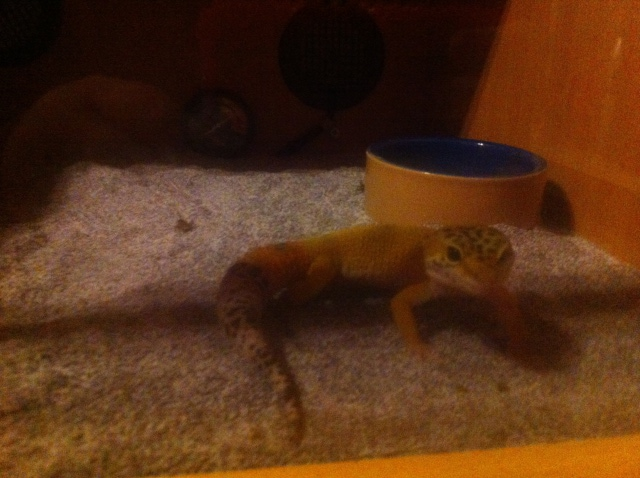 Taken a few moths ago
Taken a few moths ago
I've had my gecko for 6 months now and despite him being healthy, I'm a bit worried. Every since I got sparky he hasn't eaten a single mealworm, cricket or locust. It all started when I got him. He took a month to settle in to his home and for that month he didn't eat a thing. I was getting worried because he was so skinny,, and a friend said to take him to the vets. The nearest vets is a half hour drive each way so I phone ad explained my situation, the vets then told me that because of how far away I live taking him to the vets could put him under a lot of stress and maybe it wasn't worth it. They said to try waxworms and I did and so far it is the only thing I can get him to eat. 5 months later he is extremely healthy, a perfect weight and very happy. He loves to be held and there are no obvious signs of him being ill. I feed him 2 waxworms every other day but I still offer him mealworms and crickets just incase. I even stopped feeding him for a bit once and just put mealworms and crickets in but he refused to eat them. I've tried every food available but he won't eat anything except waxworms. I'm reluctant to take him to the vets because he doesn't cope at all well with stress. I just wanted to know if there's anything else I can try (I've tried locust, mealworms, crickets and that dried leopard gecko food that comes in a plastic pot from the pet store, he may have a nibble of this know and again) and if not is it ok to keep him on waxworms?
Thanks I look forward to your reply :)
AnswerHi Lucy,
First off I want to say you are lucky so far with the sand substrate. I really do suggest removing it. I am including a basic care sheet that I wrote to help people out. In it you will see more ideas on insects and a good item to use as a substrate. Also be sure to double check your temperatures with those I list as many times not having a proper heated area(floor and air) will cause a leo to not eat.
The fact he has gone that long w/o eating is not normal at all so it is important to find the cause. Half hour drive each way isn't a big deal at all. Placing your leo in a well padded box, he will do fine, I'm sure.
Waxworms are considered the candy of the gecko world. They are very high in fat content and can cause fatty liver disease if fed as the only diet.
I would try placing some super worms or meal worms in the same dish as the wax worms so the mealies or supers pick up the smell of the wax worms..chances are, he will still aim for the wax worms but hopefully he will grab another worm. You can also try breaking the hind legs of crickets to see if he will try them.Silk worms may be a way for you to go along with phoenix worms.
For not eating, he is thin but not horribly thin as far as I can tell. 2 wax worms every other day really isn't much at all.
I do suggest a vet visit or at least a fecal exam..
remove the sand..he may actually have a small blockage preventing him from becoming hungry.
double check all areas of care, especially temperatures.
You may have to resort to syringe feeding with blending insects..gross, I know but be prepared to do so.
Hopefully a simple change in temperatures will get him on the right track!!
BASIC CARE FOR A LEOPARD GECKO
Leopards are pretty easy to care for but they do need
special care. Here are some of the basic needs of your gecko.
HOUSING: The need to have at least a 20 gallon long tank for one Leo. This needs to have a secure fitting screen top...they can be quite the escape artists!!! They need to have a humid hide box.You can make this with something as simple as a small plastic dish with a hole cut in one side and a small mesh bag filled with some Sphagnum moss coconut bark or Peat moss that you mist.
I made mine out of the small plastic Folgers coffee containers...I cut an opening in the lid..and put the moss in..they LOVE it. I use the terrarium moss in mine.
I use that on the warm side of the tank. Be sure to provide a cool hide box on the other end. I also provide a mid temperature hide...which is in the middle of the tank.I use the critter caves which you can purchase. NOT the ones that have heat in them!!!!
Provide secure climbing areas for your gecko. Fake plants, rocks and branches are all fine to use. be sure there are no wires or sharp ends to any fake plants you use.
*****SUBSTRATE:(that's the stuff on the floor of your tank) Newspaper, lizard carpet or paper towels work great and are easy to clean and are much safer than any loose substrate. Sand or other loose substrate is not recommended as that they can be deadly to the leo when it is ingested(eaten, even by accident while eating their insects)...A very graphic site of an impacted leo surg can be seen at http://homepage.mac.com/exoticdvm/reptile/PhotoAlbum181.html it is very graphic!!! ******What I have found that works great for safety and heat distribution is using about 1/4 inch of children's play sand(since the tiles fit tight together, there is no sand danger) on the bottom of the tank and on top that you place ceramic or slate floor tile. What is nice is that the 12 x 12 squares fit perfect in a 20 gallon tank with no spaces between the tiles. The sand and the tile distribute the heat wonderfully. Using the under tank heater as described is what distributes the heat. Also, overhead heat will help in heating the tiles...I've been using this set up for several years and the leos love it. Using a tile that isn't smooth is recommended. **********
TEMPERATURES: They need a warm area ( on the floor) of 88-92 degrees and a
cooler area in the upper 70s, low 80s. At night their temperature can drop to the low to mid 70's.
Never use a hot rock for a leopard gecko...or any reptile.
They can severely burn any reptile. You can use a heating
pad under the tank,under tank heater for the warm area. You can use a regular household light bulb in a dome fixture with a ceramic socket in it to keep the warm area at the 88-92 degree area if needed there, otherwise, placing the light bulb about midway in the tank will give the needed temperatures throughout the tank. You may have to play with the wattage of the bulb but generally 40-60 watts is sufficient.At night, no white light. If room temperatures stay above 70 degrees, no extra night heat is needed. The under tank heater or heating pad should cover about 1/3 of the tank....be sure to raise the tank up about 1/4-1/2 inch off the stand when using an under tank heat source to prevent heat build up which can cause the glass to break and hot spots in the glass. Be sure to have a good layer of newspaper, carpeting or, even a thin flat rock(such as tile) on top the area that the under tank heat source is placed...if you use a thin rock or tile, it helps to distribute the heat very well.
You can use the special nighttime lights that are designed for reptiles. I like using a ceramic heat emitter on a thermostat for nighttime heat.
DO NOT use black lights or party lights as they can cause eye damage!!!!
The wattage you use will vary based on room temperature and size of tank.
LIGHTING: Leopard geckos do not need UVB lighting but it does not hurt them to give them uvb. They should have some type of light during the day, be it a uvb tube, regular florescent light, reptile day light or regular household light bulb. NO white lights at night!!!
FEEDING: Geckos should not be fed crickets or other insects that are bigger than the space between their eyes. Generally, hatchlings can be fed more than once a day,juvys can be fed twice a day, adults are fed once daily or every other day, in the early evening. Crickets and other food items such as silk worms, super, and an occasional treat of a wax worm, need to be dusted with a calcium supplement two times a week and also they should have a small dish of calcium in their tank. I use the lid of a milk jug for the little dish of calcium in their tank. For dusting the insects, Use a calcium with no added phosphorus. Insects must be gut loaded(fed) for at least 48 hours prior to feeding your gecko. Remove any uneaten crix or superworms after 15-20 minutes..... Place a piece of cut potato in the tank so that if you have missed any uneaten insects, they will eat the potato instead of nibbling on your gecko!!!
*************You have to be sure to feed your crickets and insects the right foods before feeding them to your gecko. If your crickets/insects are not healthy and well fed, your gecko will not get the nutrition he needs. You can gut load your crickets and insects greens, veggies, cereals or specially designed commercial foods for crickets or the insects you are feeding. ************
Be sure to have a small dish of clean water for your gecko at all times!!
You can offer them some baby food or fruits on occasion ...
Mine will even eat a small piece of watermelon now and then.WATER: always provide a dish of drinking water. If you choose to mist your gecko to drink, its best to not get the tank too wet as that they do not do well with higher humidity. Sometimes its better to take your leo out of their tank to mist them to get them to drink!!!
HANDLING: Some geckos enjoy being held...others prefer not to be handled at all. Be sure to be very gentle when holding your leo and NEVER grab them by the tail! Their tails are extremely fragile and will break.
I do suggest finding a vet that can treat reptiles BEFORE you actually need one!!! To find a vet that is able to care for reptiles:
http://www.herpvetconnection.com
http://www.arav.org/ECOMARAV/timssnet/amm/tnt_mdsearch.cfm
http://www.anapsid.org/vets/
For more information on leopard geckos:
http://www.drgecko.com
If you have any questions or don't understand something, please let me know.


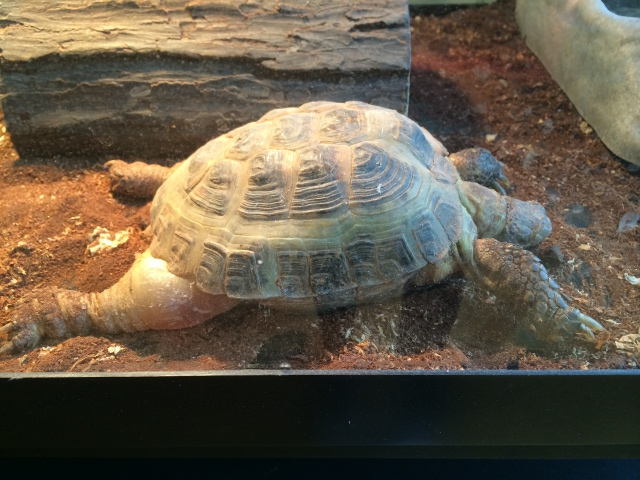 My tortoise
Question
Tortoise
My tortoises back legs have be
My tortoise
Question
Tortoise
My tortoises back legs have be
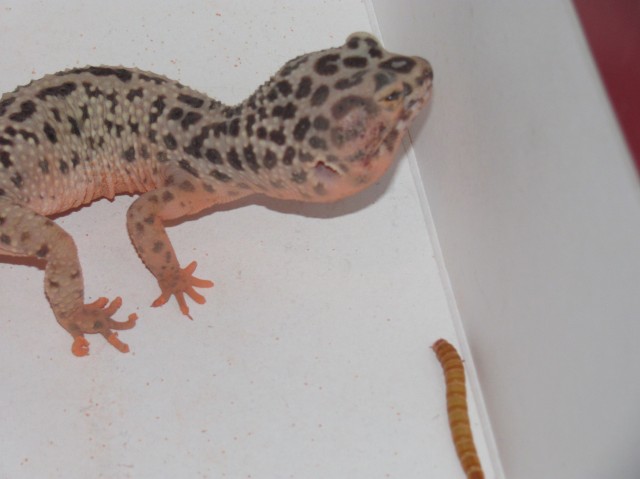 leopard Gecko with a swollen right eye
QuestionQUESTION: My daughter has about a 6-8 year old
leopard Gecko with a swollen right eye
QuestionQUESTION: My daughter has about a 6-8 year old
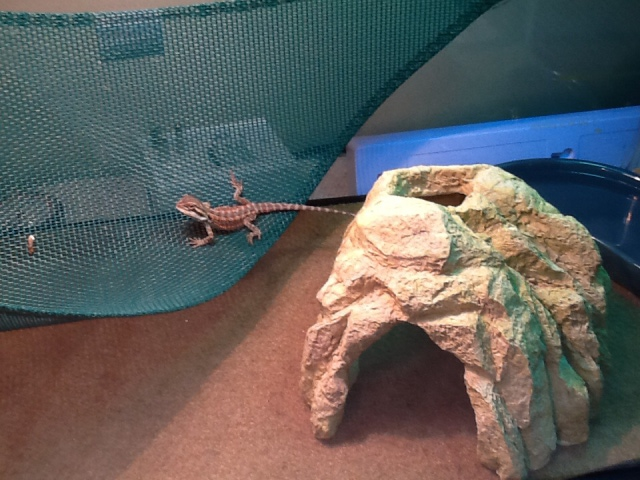 Getting my baby beardie to eat
Question
Bogie
Ive had an 8 week old baby beardi
Getting my baby beardie to eat
Question
Bogie
Ive had an 8 week old baby beardi
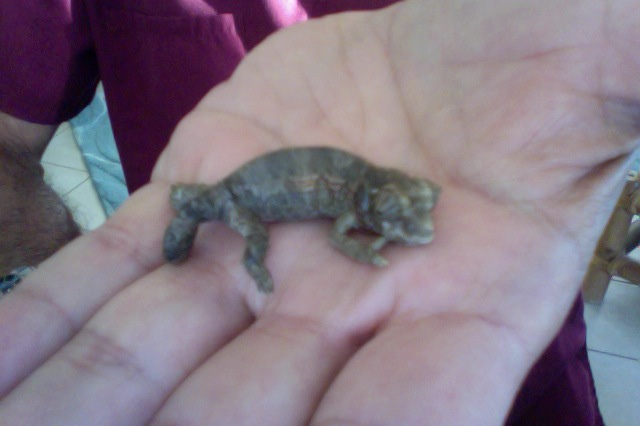 1 month old Jackson Chameleon hind legs immobilized
Question
baby jackson chameleon baby jackson cham
1 month old Jackson Chameleon hind legs immobilized
Question
baby jackson chameleon baby jackson cham
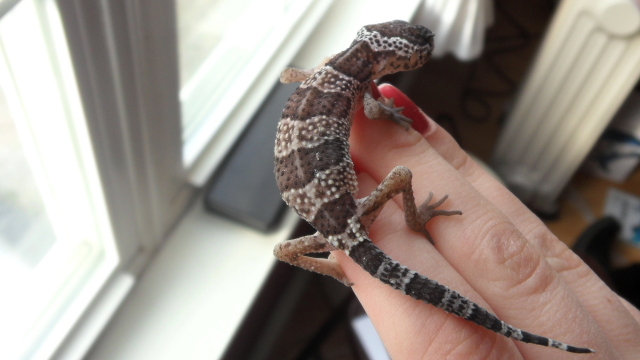 Baby Leopard Gecko with Diarrhea
QuestionQUESTION: Tracie,
Less than 48 hours ago, I bo
Baby Leopard Gecko with Diarrhea
QuestionQUESTION: Tracie,
Less than 48 hours ago, I bo